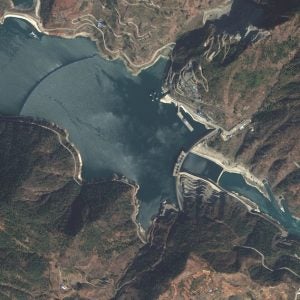Monticello dam
Monticello Dam is located on Putah Creek near Winters in Solano County, California, US. It is a medium concrete-arch dam which impounded Putah Creek to cover the former town of Monticello and flood Berryessa Valley. This created Lake Berryessa, the second largest lake in California. Water from the reservoir is supplied mostly to the North Bay area of San Francisco. The Monticello dam power plant was built at the dam in 1983 and has three generators.
The dam is noted for its classic uncontrolled spillway which has an outside diameter at the lip of 22m, slowly narrowing to 8.5m at the exit. Technically known as the morning glory spillway it is locally, somewhat more colourfully, known as ‘The Glory Hole’. When the dam reaches capacity, the spillway swallows water at a rate of 1382m3/sec.
The dam and spillway were constructed between 1953 and 1957. Other notable glory hole spillways include one at Whiskeytown Lake, near Redding also in Northern California.
Ladybower dam
Ladybower reservoir is situated at the bottom of a cascade of three reservoirs on the River Derwent in the Upper Derwent Valley in Derbyshire, UK. Construction of the dam started in 1935. Filling of the reservoir began in March 1943 but the works weren’t fully completed until 1945.
The reservoir has a surface area of 2.1km2 with a direct catchment of 124.3km2 and an indirect catchment of 72km2 from the River Noe diversion.
Ladybower dam was constructed as an earthwork embankment with a puddle clay core and upstream stone protection. The length of the dam is 380m and it was originally constructed to a height of 43m. However, in 1999, it was raised to a height of 46m to compensate for past settlement and to meet the latest flood estimation standards.
When the reservoir is full, surplus water spills into 2x24m diameter overflows which discharge into the river. The largest recorded overflow was on 4 Dec 1960 at 0.6m above the overflow, equating to 96m3/sec.






